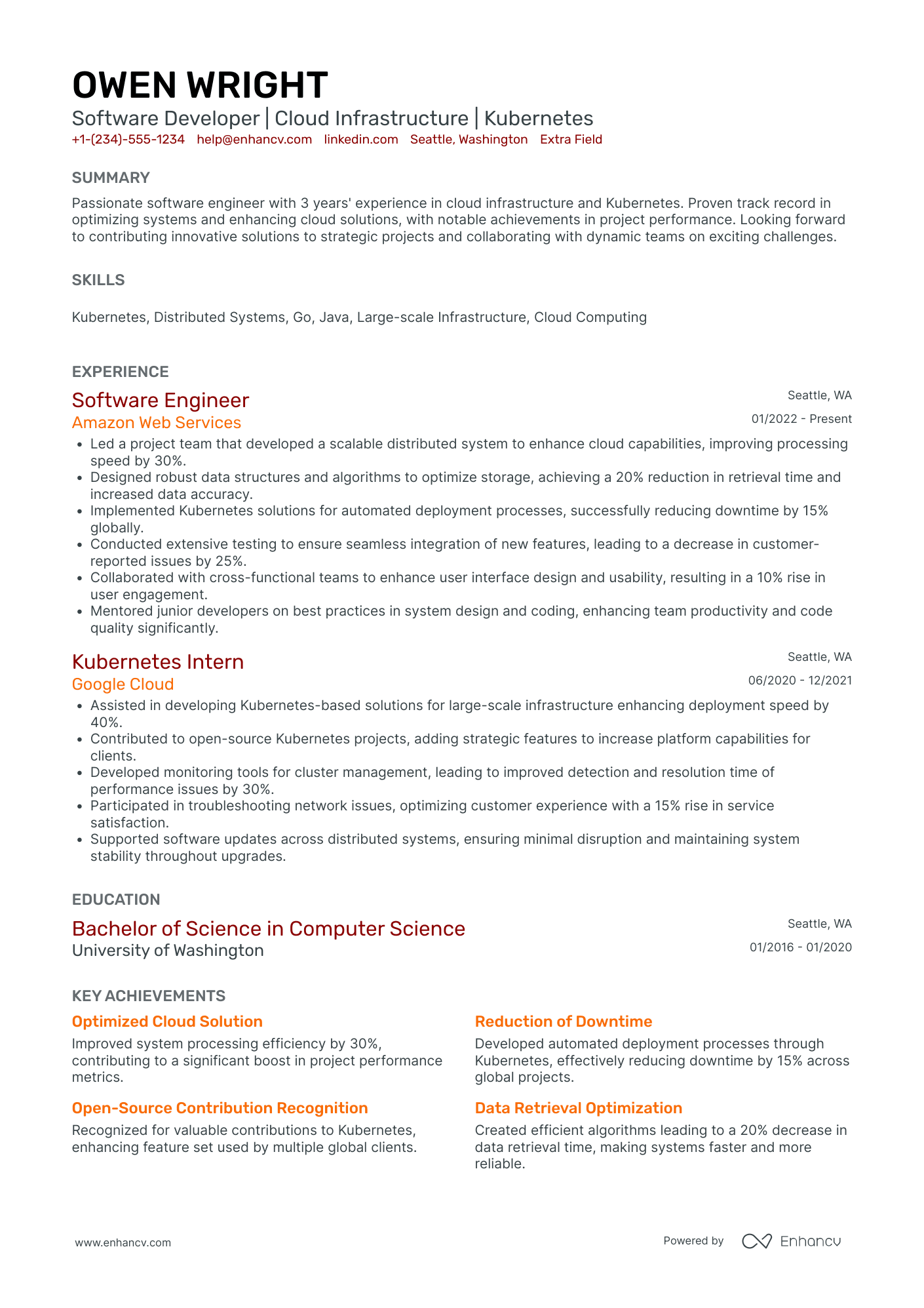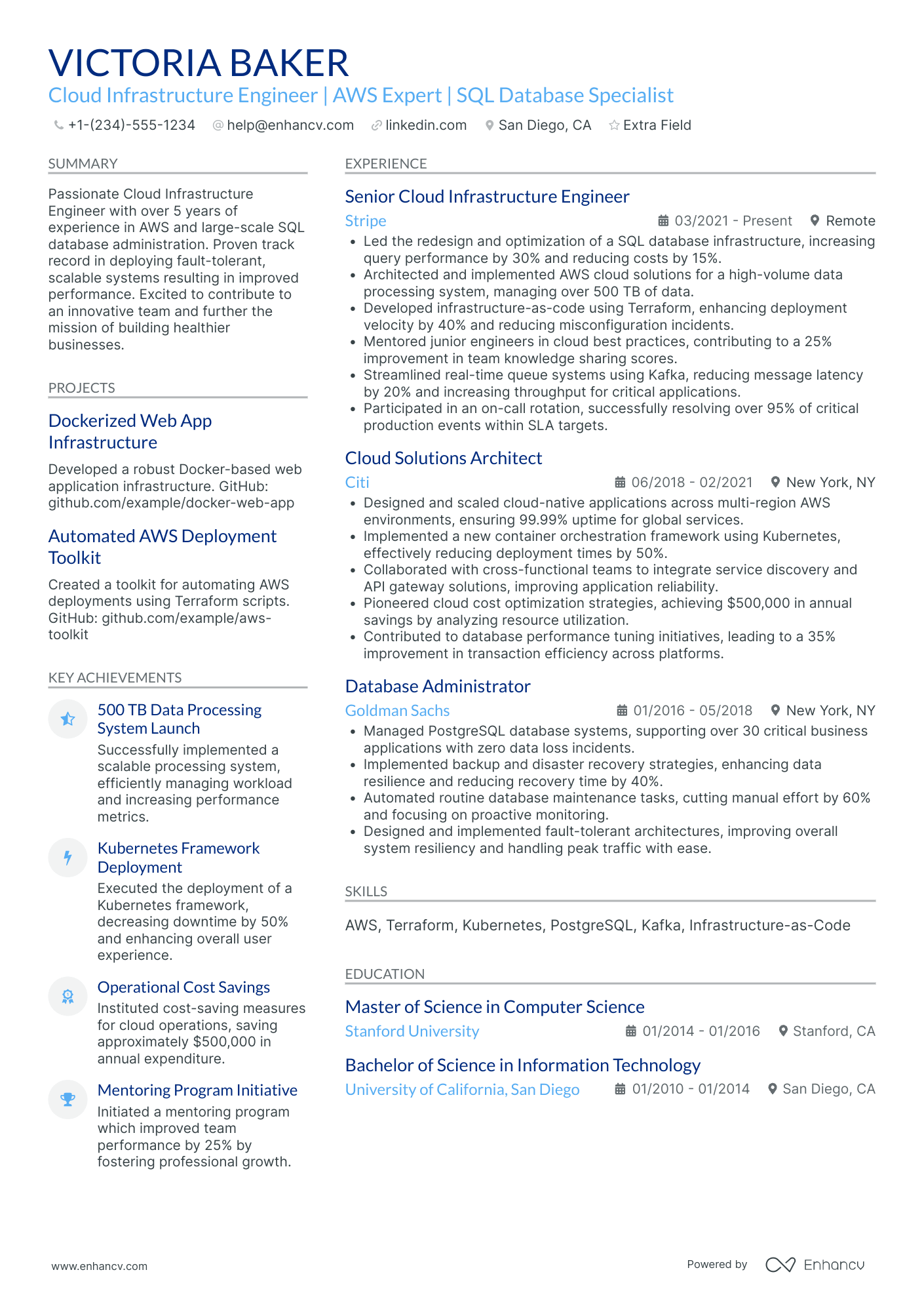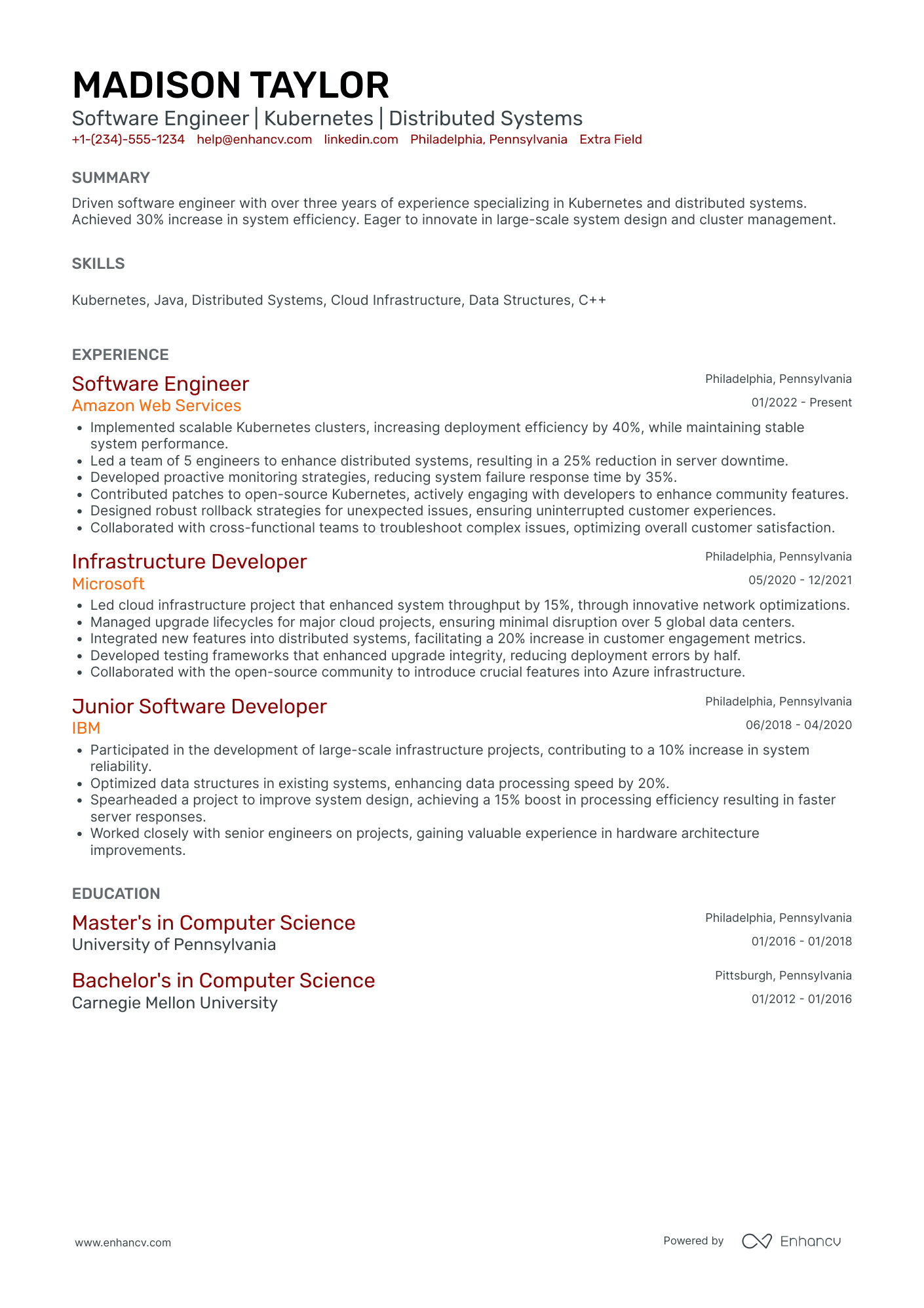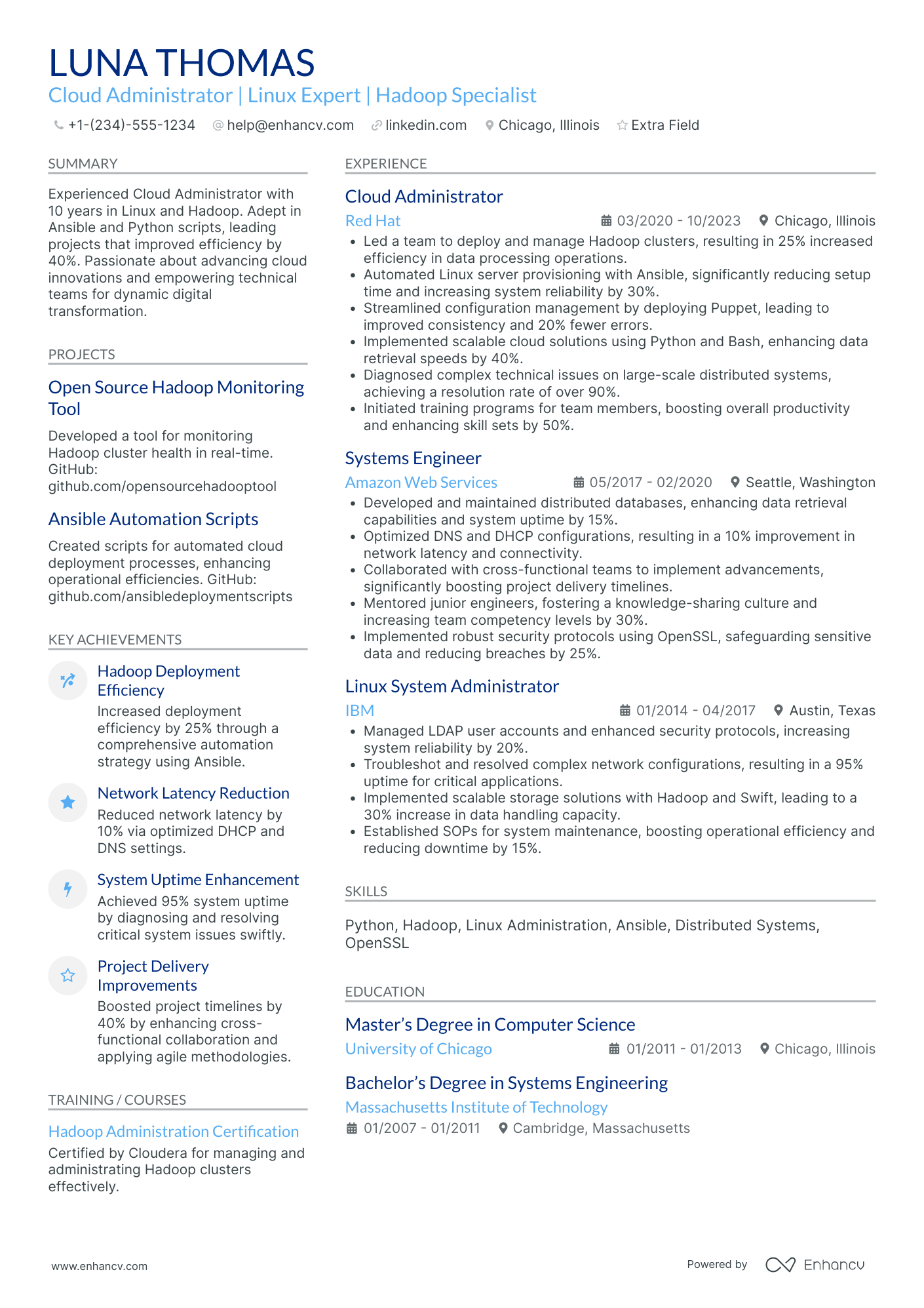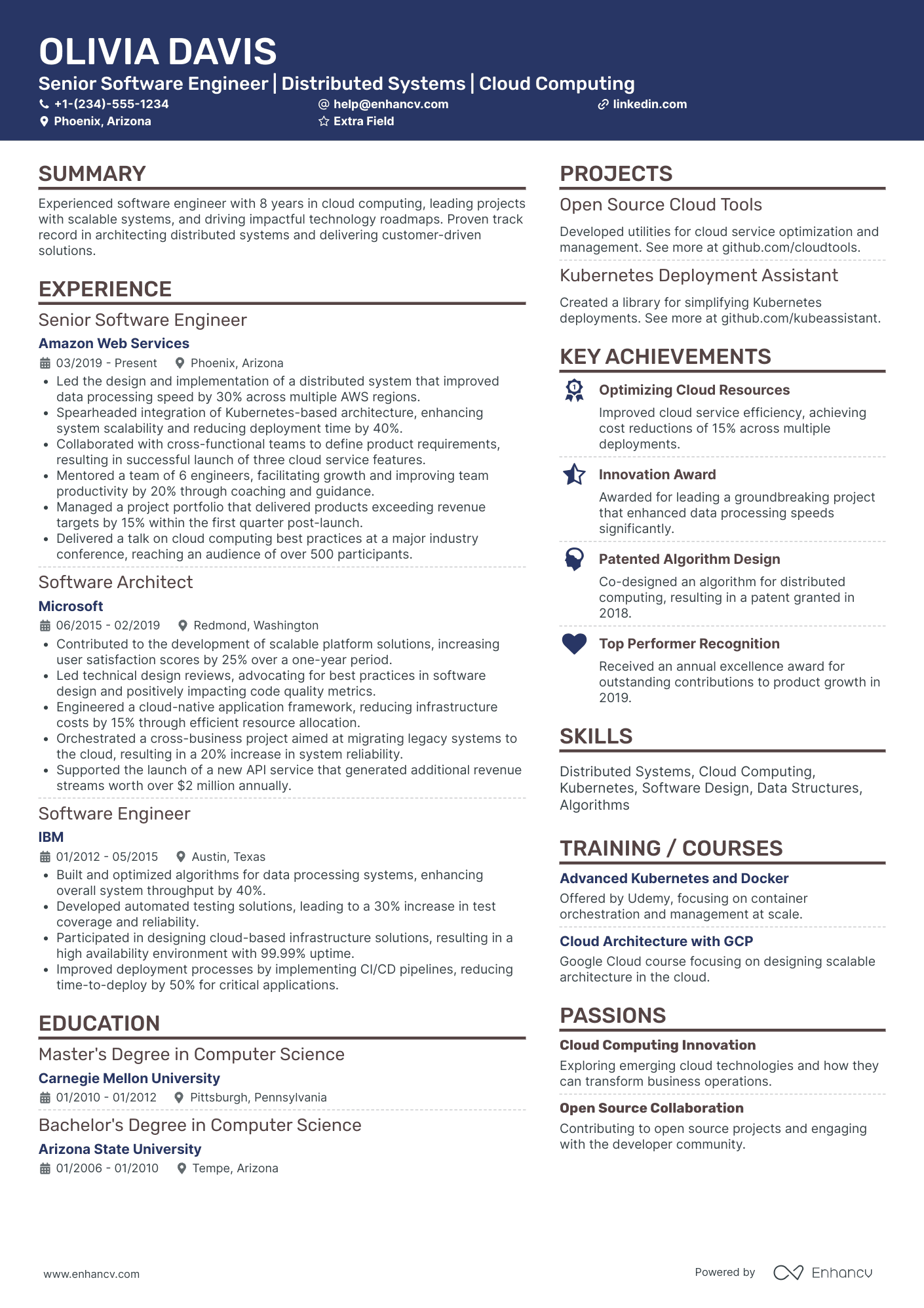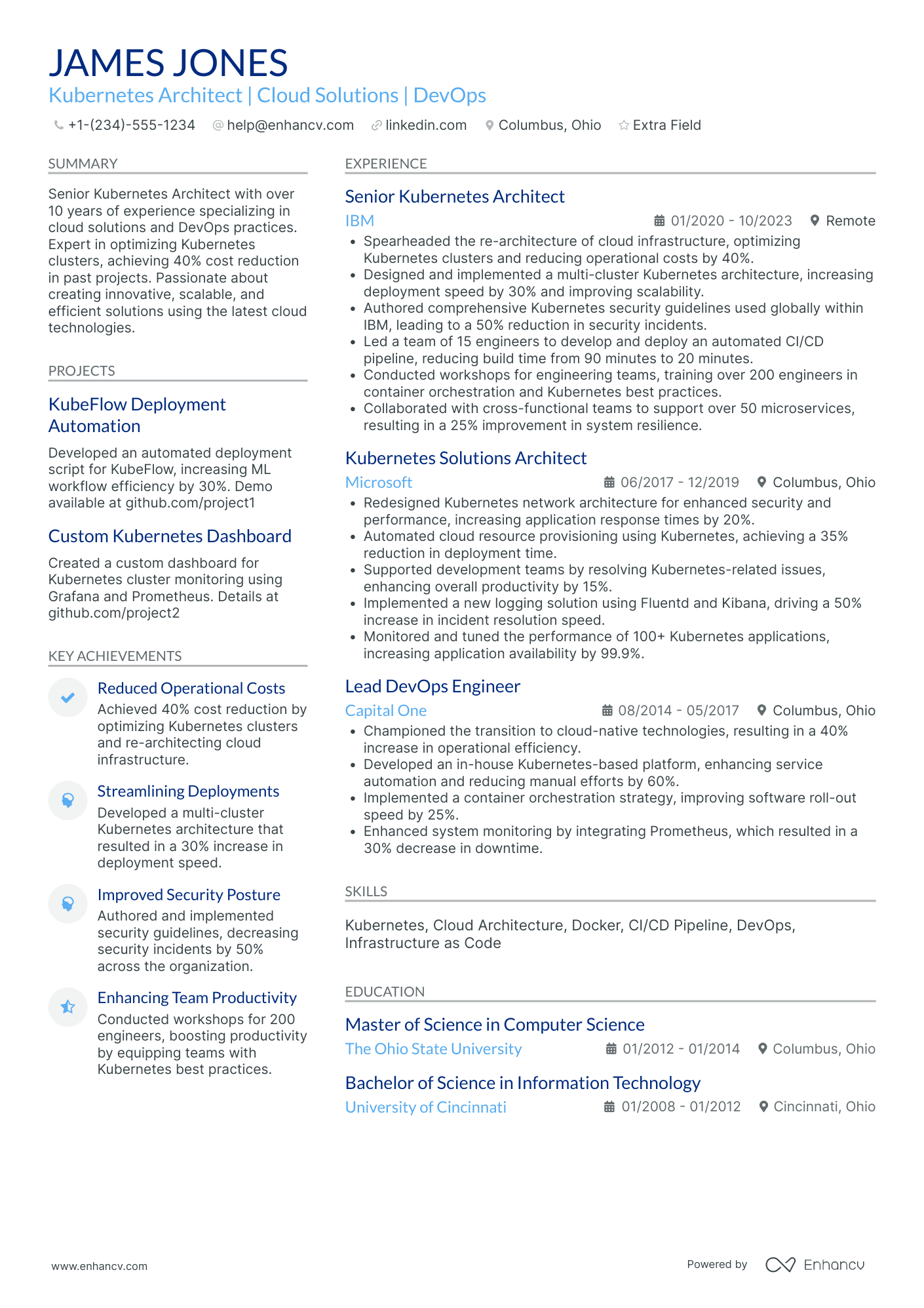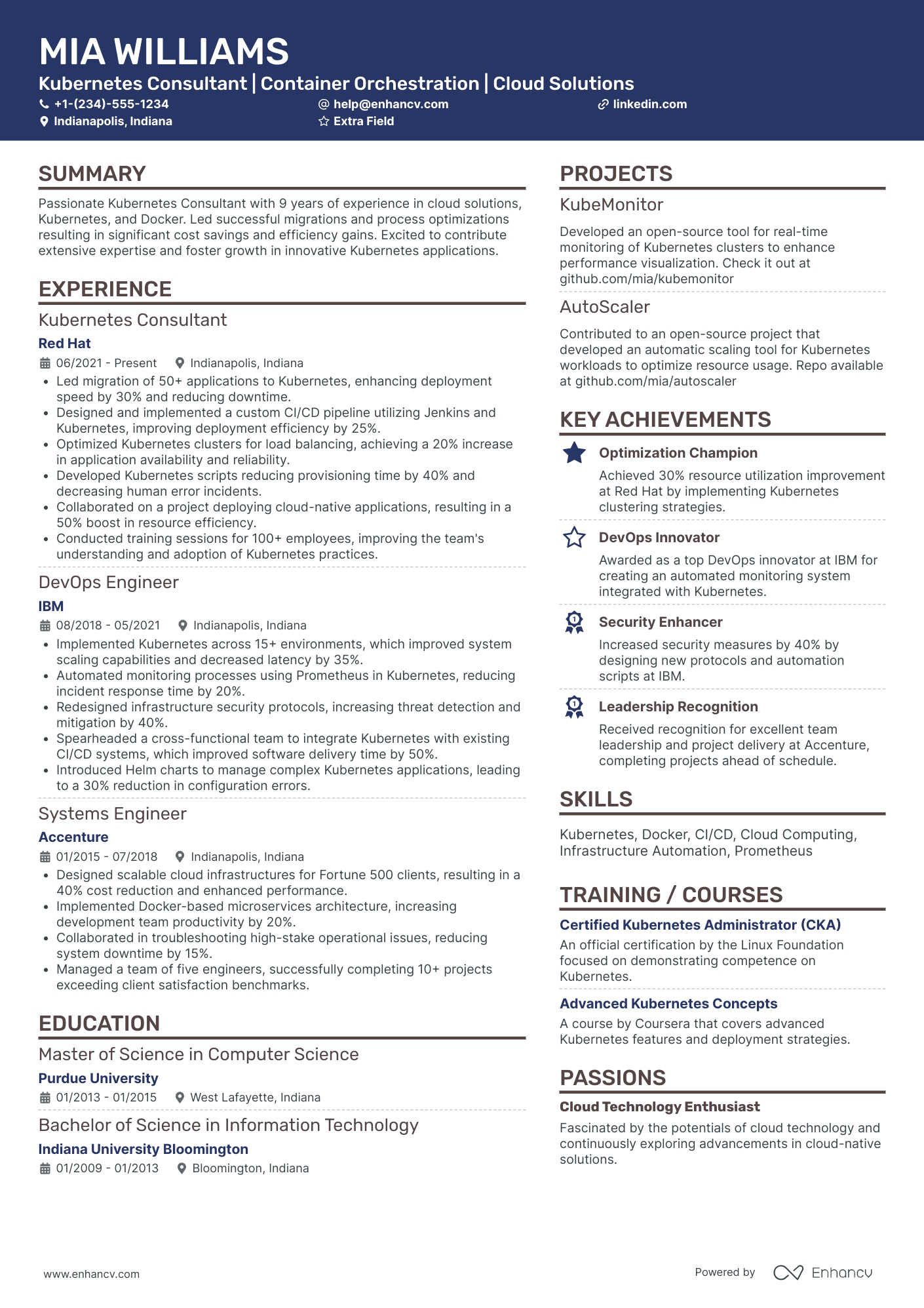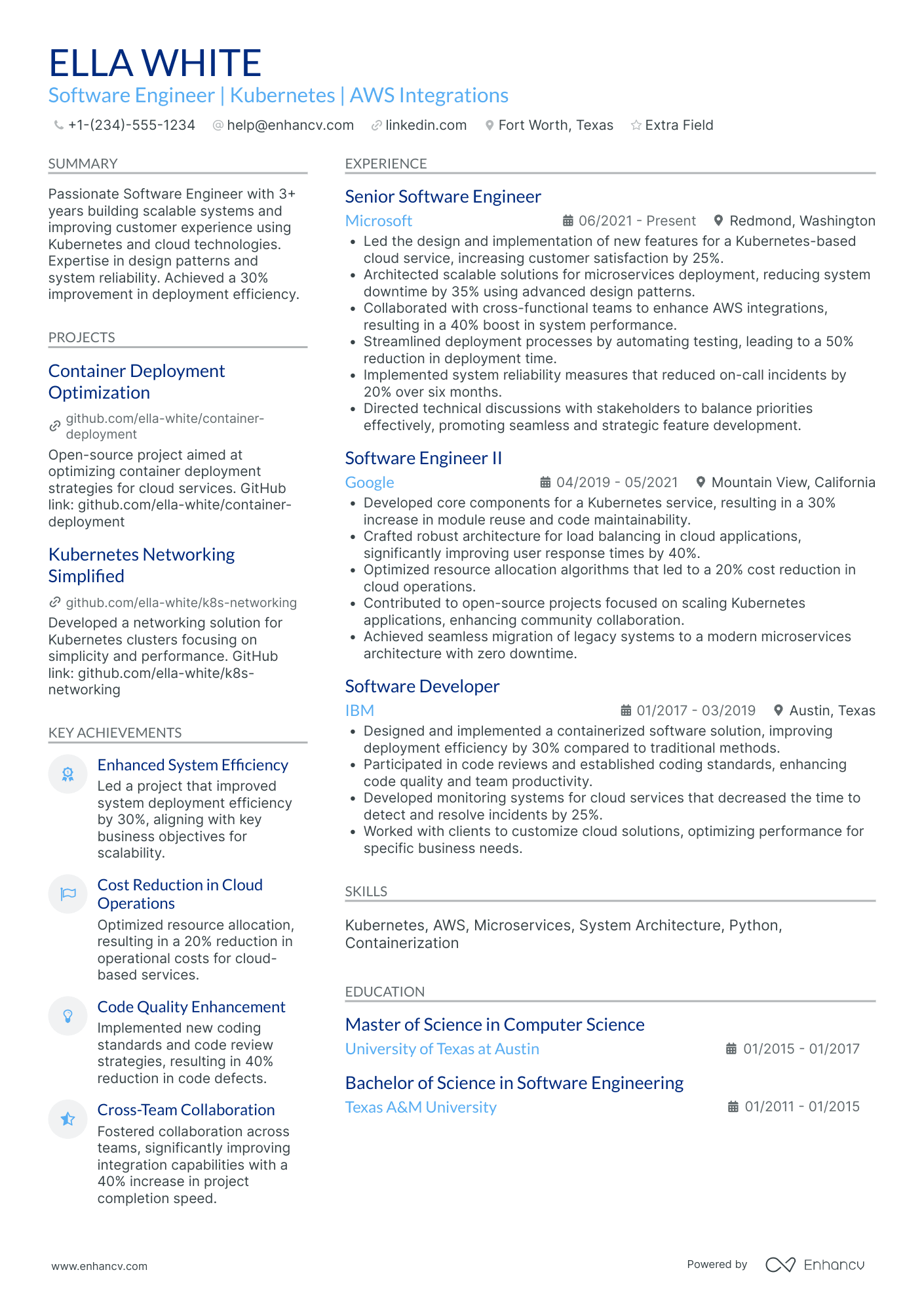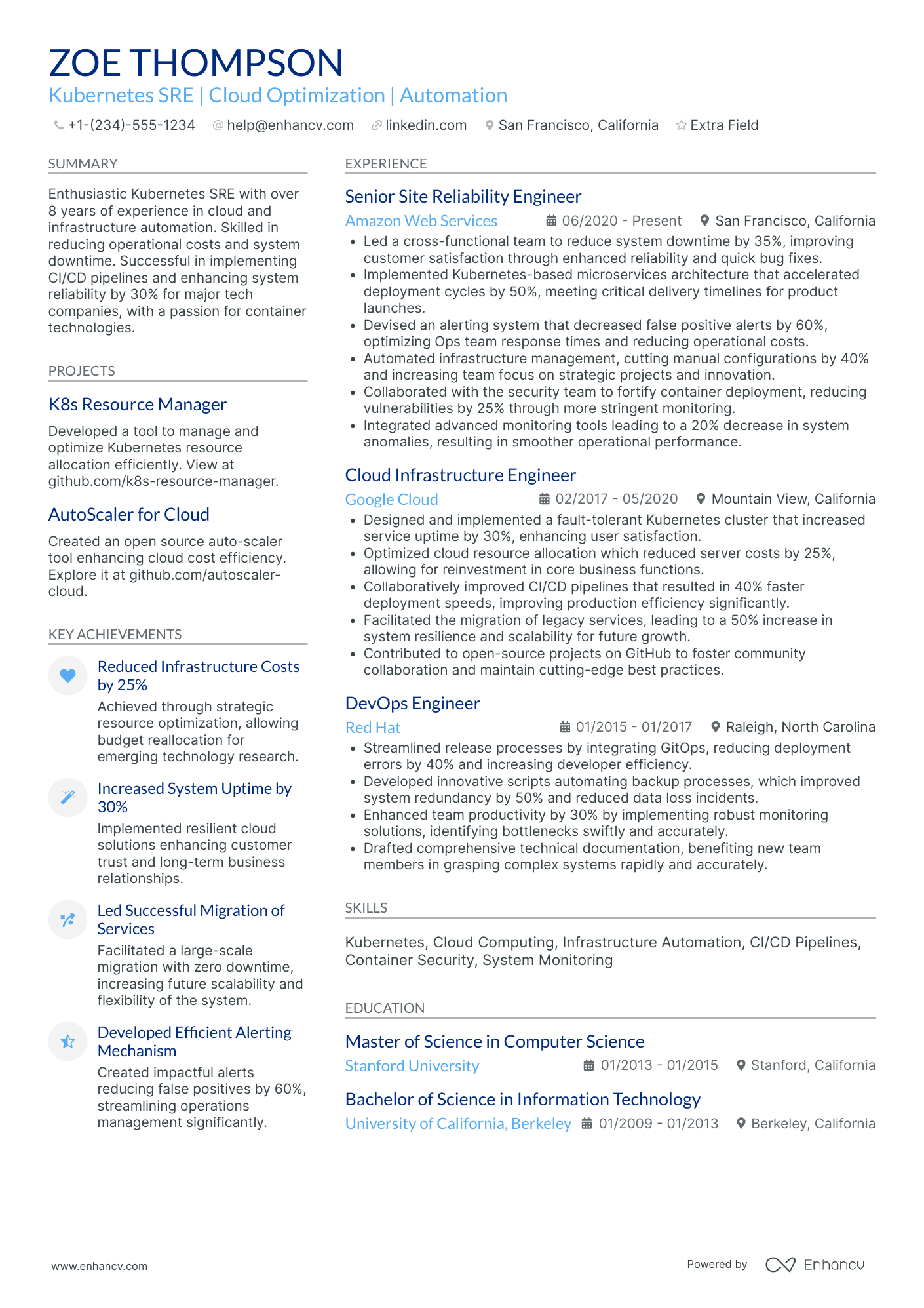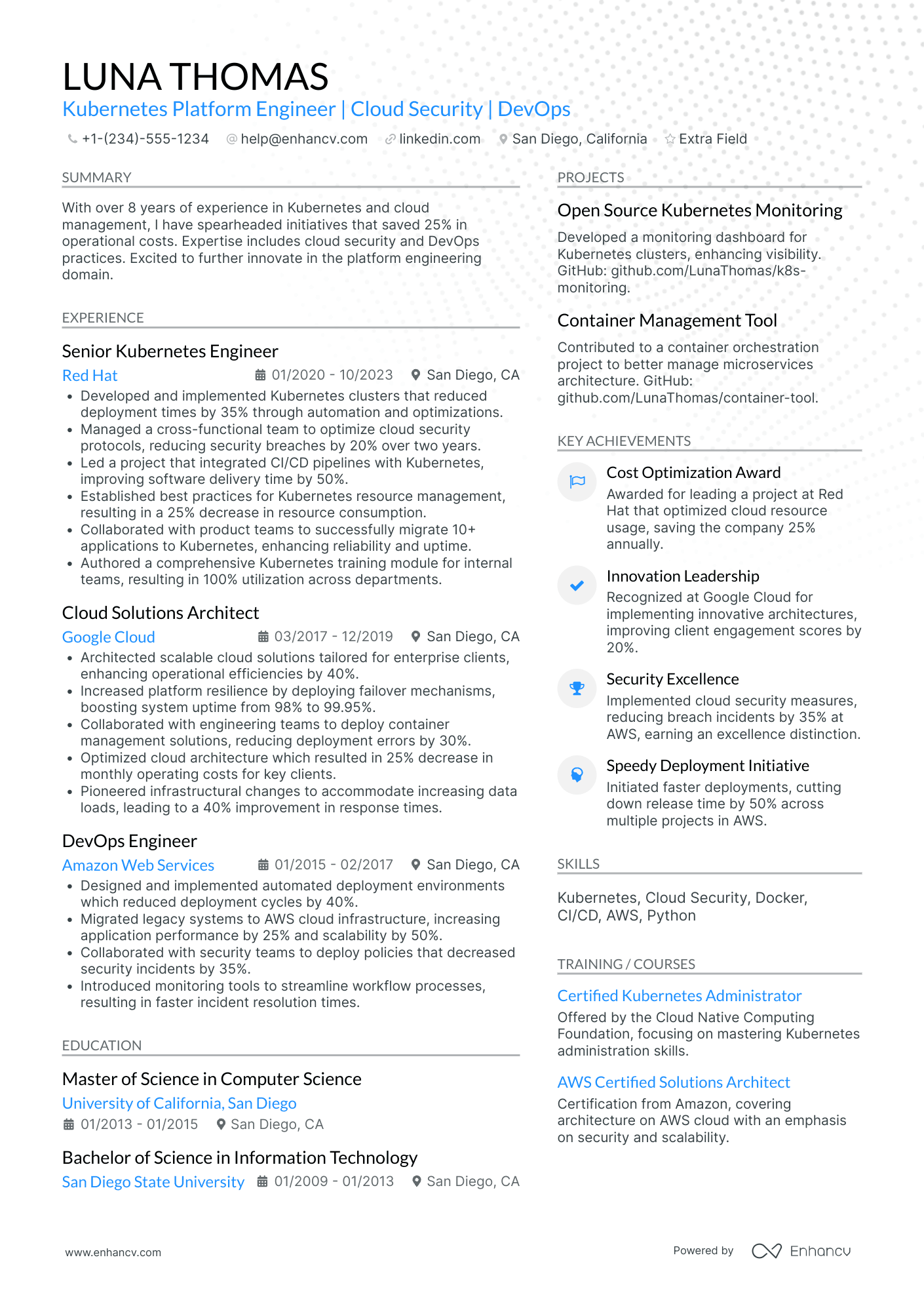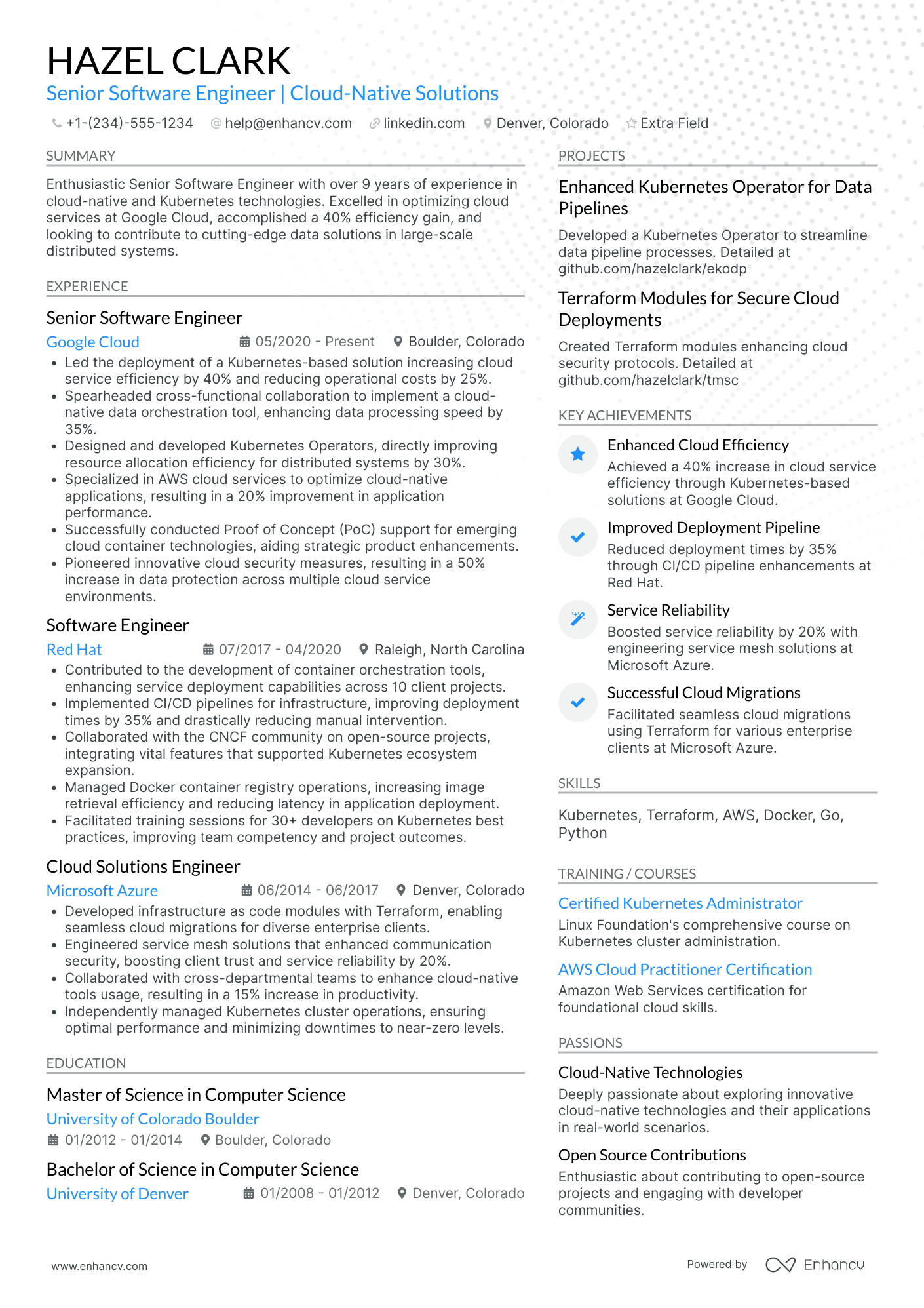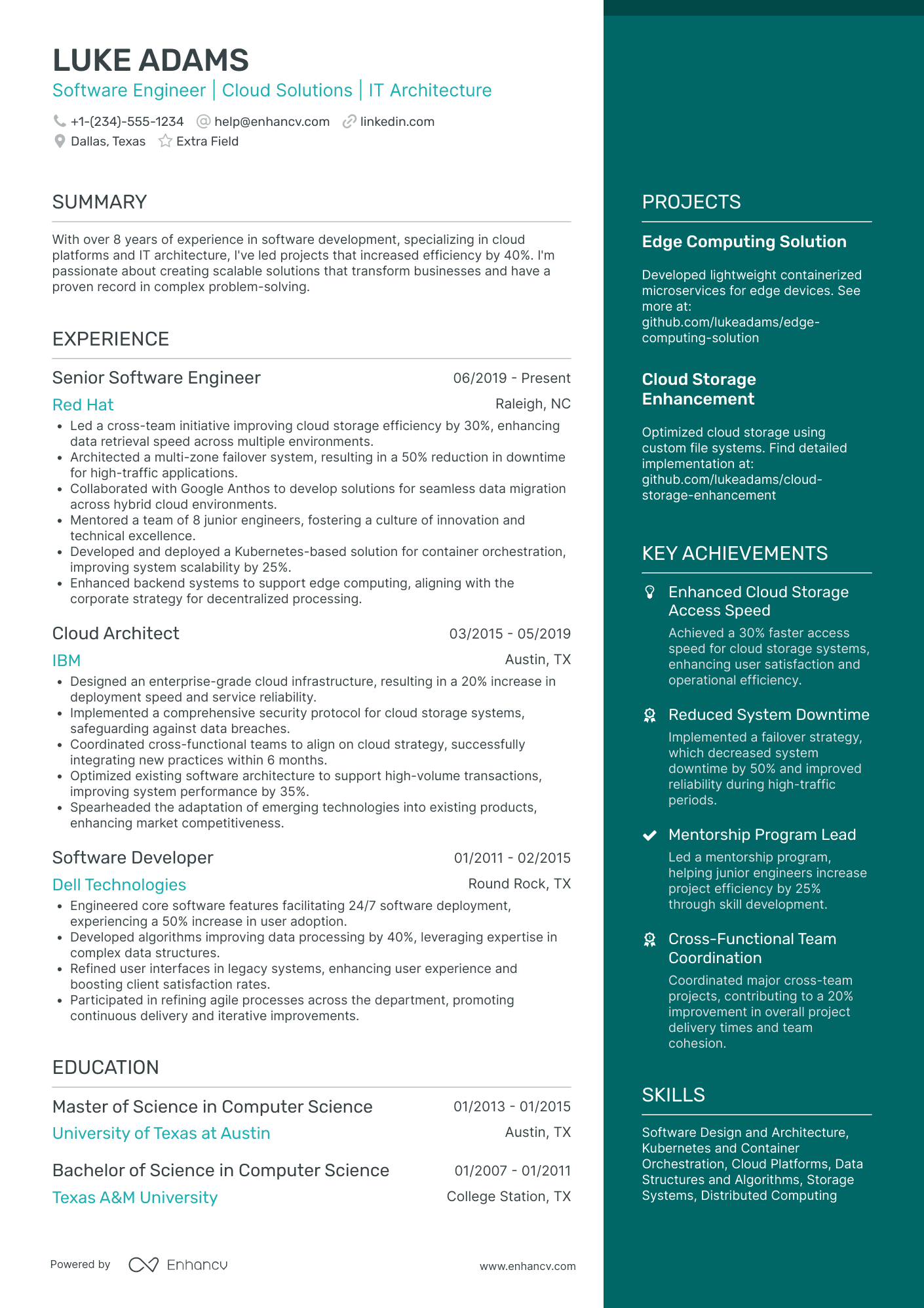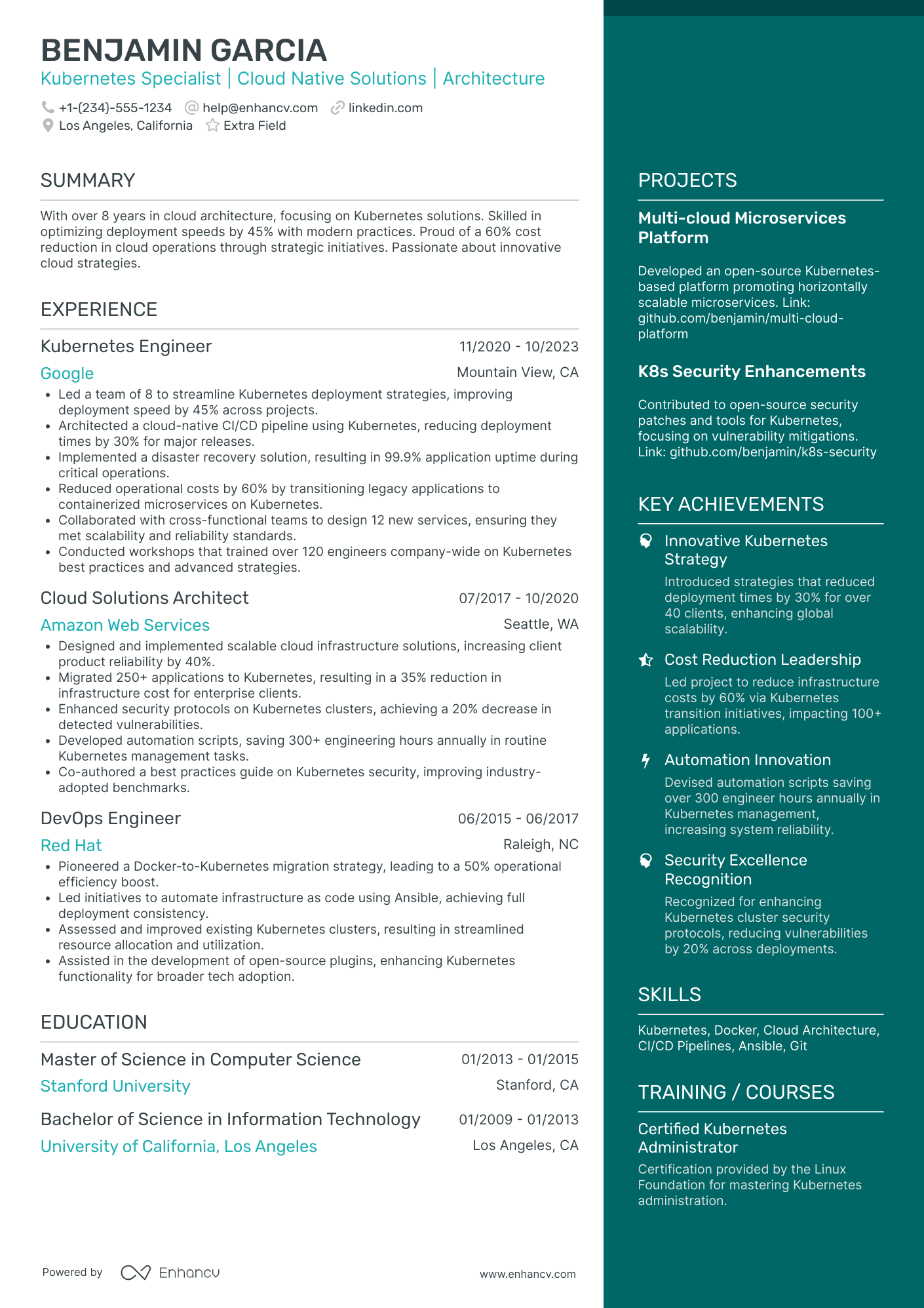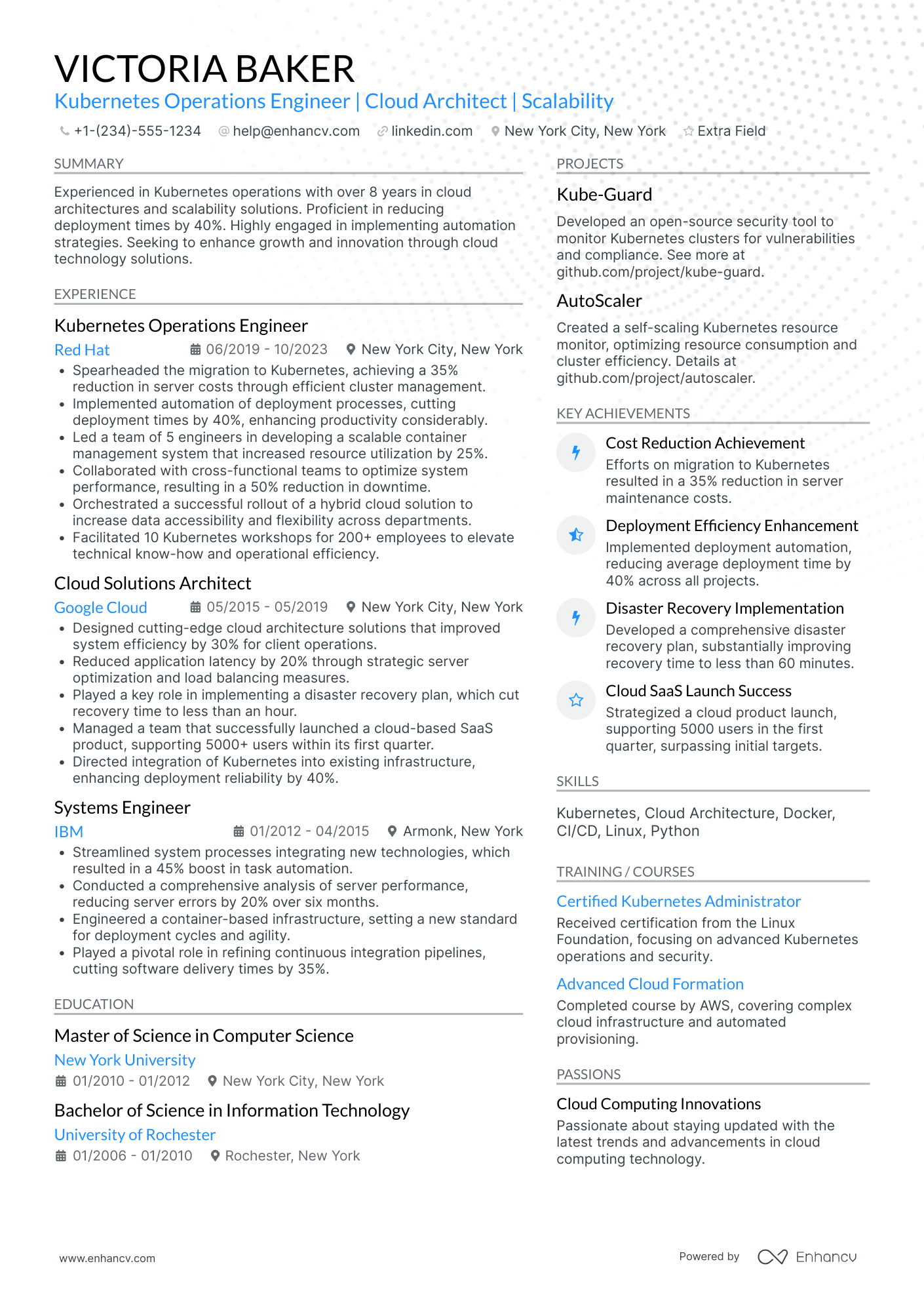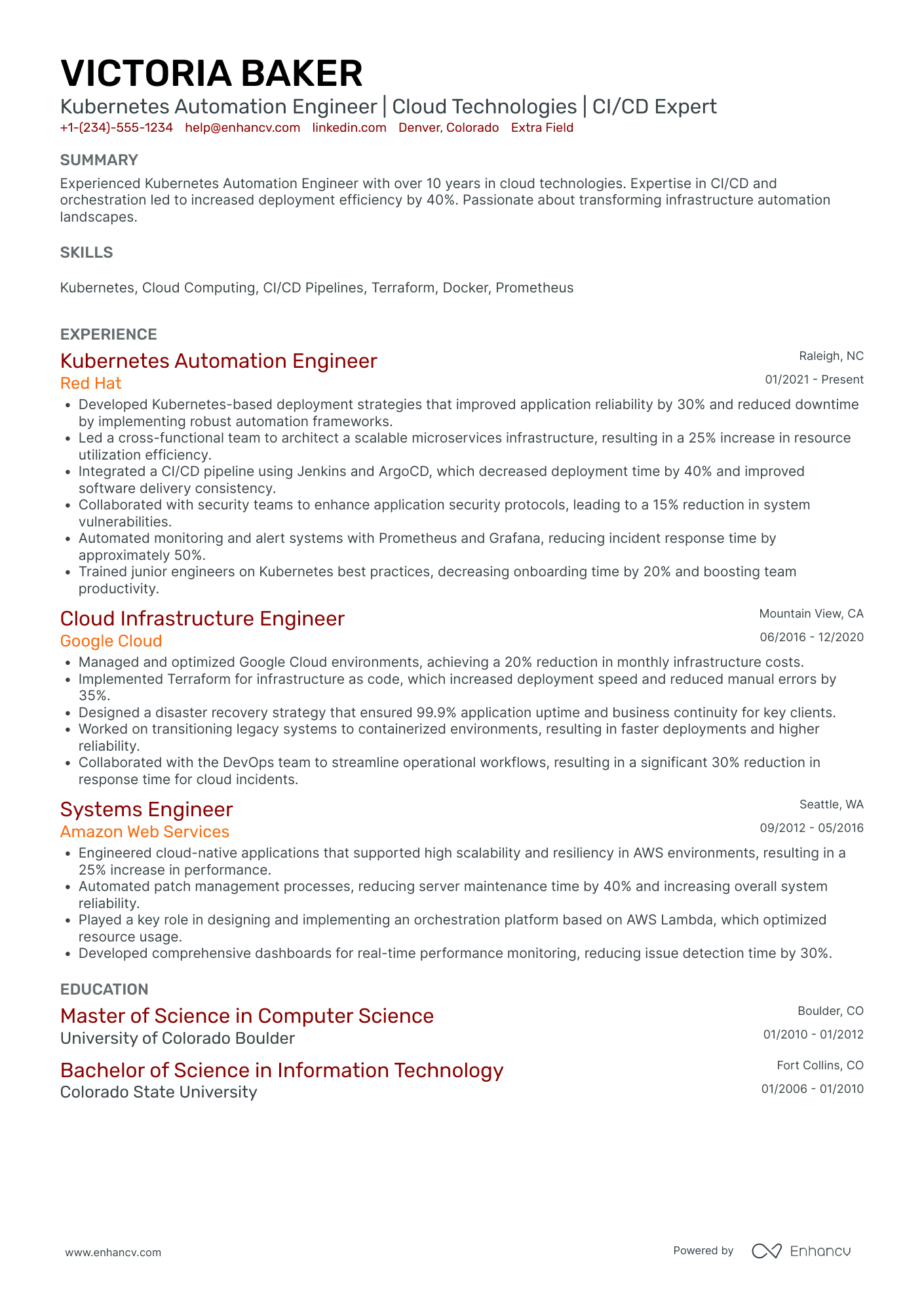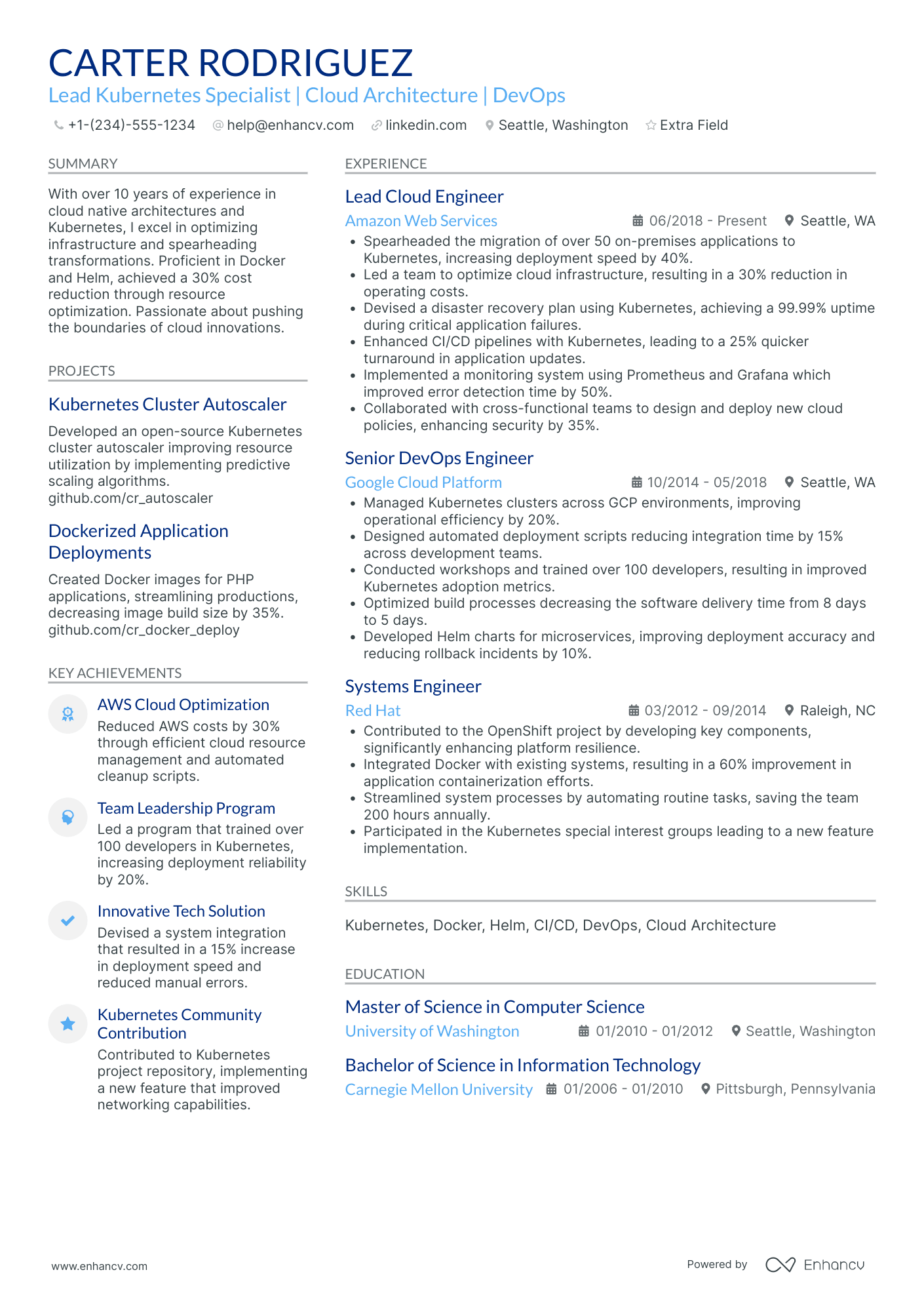With Kubernetes, there’s always something new around the corner, making sure you never stop learning and improving. It's great that you no longer have to handle servers manually, but the system remains complex and keeps you on your toes.
The constant updates in the field bring to mind the timeless wisdom of Lao Tsu.
If you give a man a fish, you feed him for a day. If you teach a man to fish you feed him for a lifetime.
Lao Tsu
Kelsey Hightower from Google puts a modern spin on this: "Give a man a Container, and you keep him busy for a day. Teach a man Kubernetes, and you keep him busy for a lifetime."
Kubernetes is like securing a job for life. And if you're wondering whether Kubectl will still be in your command line ten years from now? Absolutely because k8s is here to stay!
However, if you’re looking to land a job in this field, you'll need a striking resume. That’s where we come into the picture to help you out.
Here's what this guide will cover:
- How to choose a resume template that underlines your expertise as a Kubernetes engineer.
- How to determine the essential sections of your resume and structure them effectively.
- How to best demonstrate your experience with K8s.
- How to detail your achievements and show your impact on projects and the industry.
- How to emphasize the critical skills from the job description to meet the expectations of potential employers.
Here are a few IT engineering resume guides that may be of interest to you:
- Developer Resume
- ETL Developer Resume
- DevOps Engineer Resume
- QA Automation Resume
- System And Network Engineer Resume
- Kubernetes Cover Letter
How to format a Kubernetes resume
A solid resume format should be well-organized and intuitive, with each section leading naturally into the next, similar to an algorithm. Here are three main formats to consider for your Kubernetes engineer resume:
- If you're an experienced Kubernetes engineer, using a reverse chronological resume is advisable. This format lists your positions starting with the most recent and working backwards, underlining your career progression in tech and your specific experience with Kubernetes.
- If you're new to Kubernetes, transitioning from another tech specialty, or have gaps in your work history, a functional resume might be more suitable. This format focuses more on your skills and expertise in relevant technologies rather than the chronological order of your jobs.
- The hybrid resume is another excellent choice because it blends the best features of both the reverse chronological and functional formats. You can lead with a section that shows your most relevant skills and achievements in Kubernetes, followed by a concise work history. This approach is particularly effective if you want to spotlight specific projects or accomplishments that are directly relevant to the job you're applying for.
Here are some additional tips to make your k8s engineer resume stand out:
- Choose a visually appealing resume template that captures attention right from the start. A clean, organized layout with a professional design can make a big difference.
- Use easy to read fonts such as Arial, Rubik, or Lato, and keep the font size between 10 and 12 points to ensure readability.
- Maintain uniform margins, typically around 1 inch, to give your resume a neat and structured appearance.
- Open with a header that includes your name, professional title (such as Kubernetes Engineer), contact information, and a link to your LinkedIn profile or GitHub repository if applicable.
- Select resume colors that are gentle on the eyes. Blue is a great choice, as it conveys professionalism and suits a variety of tech environments.
- Make sure to save your resume as a PDF over to a DOC file to maintain its formatting on any device.
These strategies will help you create a strong resume that's both ATS-friendly and attractive to recruiters seeking skilled Kubernetes pros.
17% of hiring professionals are discouraged by resumes that exceed two pages in length.
Make sure to use our intuitive AI resume checker. It reviews your resume on 16 key points for free.
Is your resume good enough?
Drop your resume here or choose a file. PDF & DOCX only. Max 2MB file size.
After finalizing the structure, we'll craft a resume that's hard to turn down. We'll go over the key sections of your k8s resume in this guide.
The top sections on a Kubernetes resume:
- Skills section: Include this to detail your proficiency with Kubernetes, other container tools, and cloud platforms as this shows your technical competency for the role.
- Work experience section: It helps to show your practical exposure and achievements in using Kubernetes or related technologies in past jobs.
- Certifications section: The right place to list industry-specific qualifications like Certified Kubernetes Administrator or Certified Kubernetes Application Developer that validate your skills.
- Project section: Listing your Kubernetes projects or case studies can provide evidence of your hands-on experience and problem-solving capabilities.
- Education section: This allows you to mention the degree you hold which is typically required for Kubernetes roles and showcases your broad foundational knowledge in the field.
Consider what points within these sections catch a recruiter’s eye and what they prioritize when reviewing your application.
What recruiters want to see on your resume:
- Proficiency in Kubernetes: Recruiters prioritize this to ensure that you're comfortable deploying, scaling, and managing applications in Kubernetes.
- Understanding of cloud platforms: A working knowledge of cloud platforms like AWS, Azure or GCP is crucial for integrating Kubernetes in cloud-based deployments.
- Experience with DevOps tools: This demonstrates that you can automate tasks and processes, a key aspect of managing Kubernetes environments efficiently.
- Relevant certifications: Certifications like Certified Kubernetes Administrator or Developer are highly valued as they confirm your specialized knowledge and skills.
- Strong problem-solving abilities: Kubernetes roles often involve troubleshooting and optimizing container orchestration, making strong problem-solving abilities critical.
No matter the structure of your resume, you’ll often start with the experience section. Let us guide you in setting it up correctly for a Kubernetes resume.
How to write your Kubernetes resume experience section
In the experience section of your Kubernetes resume, focus on your accomplishments rather than just listing your duties. Make sure to read the job description carefully to identify relevant keywords related to the skills and tools required for the role. For Kubernetes, you might want to highlight your experience with:
- Docker/ Containerd;
- Linux;
- YAML templates;
- Computer networking;
- ArgoCD;
- Helm;
- Prometheus, etc.
Provide specific examples where you've effectively used these technologies to solve problems. Describe the challenges you faced, the solutions you implemented, and the outcomes.
Employers value candidates who show they can solve problems and meet the needs of end users. You have bonus points if you can handle issues quickly and cost-effectively. Your resume should reflect these qualities to help you stand out as a top candidate.
Now, let's review what sets apart a failing experience entry from a successful one.
- •Managed multiple Kubernetes projects, focusing on deployment and scaling activities.
- •Utilized various Kubernetes tools to streamline operations and enhance system performance.
- •Contributed to team efforts in monitoring and optimizing cloud resources and system functions.
Right now, your resume kind of just lists what you did—it's not very exciting. It’s important to breathe life into your responsibilities by including numbers and results. They show not just what you did, but how well you did it and the difference it made. That’s the stuff that gets you noticed, both by people and ATS filters!
Take a look at the new version:
- •Led the deployment and scaling of over 10 Kubernetes projects, achieving a 40% improvement in deployment speed and system scalability.
- •Implemented advanced Kubernetes tools and techniques that reduced system downtime by 25% and enhanced overall performance metrics.
- •Played a key role in a team that optimized cloud resource usage, saving the company approximately $100,000 annually on operational costs.
- •Developed and enforced best practices in Kubernetes cluster security, reducing security incidents by 50% over a two-year period.
The use of action verbs like "led," "implemented," and "developed" subtly underscores the candidate's proactive role and leadership capabilities.
What really sets this section apart are the specific numbers that spell out the candidate’s successes—like boosting deployment speed by 40%, cutting operational costs by $100,000 annually, and halving security incidents. These figures don’t just tell us what the candidate did. They show how effectively they did it, making their achievements both clear and compelling.
Moreover, the detailed mention of technologies directly used in projects serves as proof of a candidate's technical fluency.
TalentWorks recommends boosting your interview chances by 40% simply by quantifying your achievements on your resume.
This is exactly why the next section is crucial for any Kubernetes resume.
How to quantify impact on your resume
Here are some ideas for professionally presenting your quantifiable achievements:
- Document your experience in building and managing Kubernetes clusters, specifying the number of nodes you have handled which demonstrates your scalability skills.
- Mention the number of Docker images you created and managed, showing your ability to handle containerized applications.
- List the number of deployments you have done using CI/CD pipelines, this speaks volumes about your ability to automate deployment processes.
- Include the number of issues resolved related to Kubernetes orchestration, showcasing your problem-solving skills.
- Quantify the overall system performance improvement percentage after your optimization practices, indicating your contribution to efficiency.
- Include the number of automated scripts written for Kubernetes administration demonstrating your automation capabilities.
- Specify the number of security protocols you implemented in Kubernetes projects, which demonstrate your understanding of security concerns.
- Detail the percentage of cost savings in resources or cloud usage through your efficient Kubernetes management practices, proving your cost-efficiency capabilities.
PRO TIP
Don’t put lies on your resume. They’ll likely come out in the interview, and that’s a sure way to get your application tossed.
This is really important if you don’t have a lot of experience and are tempted to stretch the truth on your resume. If you’re looking to become a Kubernetes engineer, be sure to read the tips in the next section. They’ll give you the right tools to move your application forward without any exaggerations.
How do I write a Kubernetes resume with no experience
If you're just starting out as a Kubernetes engineer, consider working on personal projects before applying for a job. Simple tasks, such as deploying small applications using Kubernetes or adjusting cluster configurations, are good starting points. You can find many resources on platforms like GitHub or Stack Overflow to improve your skills in managing containers.
If you already have some projects to show, you can list them in your resume’s experience section. Here’s how:
- Describe your personal projects as freelance work or as part of your education.
- Include any technical workshops or competitions you've participated in, particularly if you received any awards or recognition.
- List your participation in relevant online communities, especially if they relate to DevOps or Kubernetes.
- Highlight transferable skills like teamwork, problem-solving, and managing complex systems, and use examples from school or previous jobs to show how these abilities can apply to k8s roles.
- Begin your resume with a clear objective statement. Share your enthusiasm for Kubernetes and mention any related experience. Keep it concise—aim for 3-4 sentences.
All these parts show that you are proactive and capable, which are key traits in the tech industry.
How to list your hard and soft skills on your resume
When creating the skills section of your Kubernetes resume, you want to keep it neat and impactful. Include both technical expertise in tools such as Docker and Kubernetes and soft skills that demonstrate adaptability and teamwork. Highlight your proficiency in programming languages, particularly Go.
Best hard skills for your Kubernetes resume
- Kubernetes
- Docker
- Cloud platforms (AWS, Azure, GCP)
- CI/CD tools (Jenkins, CircleCI)
- Configuration management (Ansible, Puppet, Chef)
- Infrastructure as code (Terraform, CloudFormation)
- Linux/Unix command-line interface
- Networking concepts
- Container security
- Shell scripting
- Python
- YAML
- Helm
- Prometheus
- Grafana
- Git version control
- Microservices architecture
- Container networking
Besides hard skills, show off your personality by mentioning your top soft skills. They’ll assure recruiters that you can get along with the team and fit into the company culture.
Best soft skills for your Kubernetes resume
- Decision making
- Problem-solving
- Teamwork
- Communication
- Multitasking
- Time management
- Attention to detail
- Stress management
- Patience
- Resilience
- Critical thinking
- Perseverance
- Initiative
- Flexibility
- Creativity
- Proactiveness
- Learning agility
Now that we’ve discussed the essential skills for Kubernetes, let's explore the required educational background.
How to list your education and certifications on your resume
For a technical career, particularly in Kubernetes, a computer science degree or related is usually necessary. Nonetheless, for roles that demand extensive experience, such as a senior DevOps engineer working with Kubernetes, professional experience is more critical than academic background.
When applying for entry-level positions, prioritize your education by highlighting relevant programming coursework on your resume.
Here's how to tailor the education section of your resume for a Kubernetes role:
- Degree name: Specify the degree you have obtained, relevant to your field.
- Institution name: Name the institution where you received your education.
- Graduation date: Indicate when you graduated or when you expect to graduate.
- Field of study: Mention your field of study, focusing on areas like computer science, software engineering, or information technology which are pertinent to Kubernetes roles.
- Certifications: Include relevant Kubernetes or cloud technology certifications, such as Certified Kubernetes Administrator (CKA) or Certified Kubernetes Application Developer (CKAD).
- Additional training: List any additional training courses or bootcamps you’ve completed that are relevant to Kubernetes and cloud computing.
- GPA: If your Grade Point Average is above 3.5, consider including it to show academic excellence.
PRO TIP
Your major should always come before your minor in the education section of your resume.
Here's the right way to structure this part of your resume.
- •Specialized in cloud computing and container technologies.
- •Completed a thesis on automated Kubernetes cluster management.
- •Focused on software development and systems architecture.
- •Engaged in multiple projects using Docker and microservices.
Getting advanced Kubernetes certifications shows your expertise and proactive way of handling today's tech challenges. Listing your certifications is pretty simple. Here's what you need to do:
- Mention the qualifications you've got.
- Include the name of the organization that issued them.
- If applicable, note the expiration date of each certification.
Here are some valuable certifications to add to your resume:
Best certifications for your Kubernetes resume
Consider these certifications as suggestions. Always check the job description to see which ones are required for the particular role you're interested in. Organize this section well so that your most recent certifications stand out to hiring managers.
PRO TIP
If you failed to obtain one of the certificates, as listed in the requirements, but decide to include it on your resume, make sure to include a note somewhere that you have the "relevant training, but are planning to re-take the exams". Support this statement with the actual date you're planning to be re-examined.
How to write your Kubernetes resume summary or objective
When tech companies go through piles of resumes, yours can grab attention with a skillfully written summary or objective. Focus on highlighting your Kubernetes expertise and your ability to manage complex systems to capture their attention. Both a resume summary and an objective can quickly draw the recruiter's attention and prove that your skills and experiences align with what they’re looking for.
So, what’s the difference between the two?
- Objective statement: Keep this short, about 3 sentences, emphasizing your career ambitions and why you're interested in the role. It's ideal if you're entering the field, considering a career change, or returning to work after a break.
- Summary: This should be a brief overview of your top professional achievements and relevant skills, consisting of 3 to 5 sentences. It's most effective if you have significant experience in Kubernetes or similar technologies.
Curious to see how they work? Check out the example of a resume summary below:
Next, here's an example of an objective statement:
Here are effective strategies for crafting an impressive summary or objective tailored for a Kubernetes engineer role:
- Quantify achievements: Demonstrate your impact with specific examples. For instance, "Managed over 50 Kubernetes clusters, enhancing system reliability by 40%." These details underline your contributions to system efficiency and stability.
- Customize: Adapt your summary or objective to align with the specific demands of the Kubernetes engineer position and the company you're applying to.
- Highlight crucial skills: Emphasize essential skills for Kubernetes engineering, such as expertise in system scalability, continuous integration practices, and strong problem-solving abilities.
Taking the time to create a clear and specific summary or objective can give your resume a significant boost.
Additional sections for a Kubernetes resume
Besides the essential parts of your resume, you can include additional sections to showcase different facets of your expertise, particularly those that don’t neatly fall into standard categories.
Based on the job you're applying for and its unique requirements, there are several sections you might consider adding. For instance:
- Volunteering: Include any volunteer experience, particularly if it involves roles related to technology or community outreach. This highlights your commitment and willingness to extend your skills beyond paid work.
- Achievements: Show significant accomplishments such as contributions to open-source projects or recognition at tech conferences to demonstrate your dedication and capability in the field.
- Language skills: If you speak multiple languages, be sure to include this information. Being multilingual is a great asset in any environment.
- Passions: Sharing your hobbies and interests outside of work, like tech blogging, joining hackathons, or even unrelated activities like hiking or photography, shows you're a well-rounded candidate with a balanced lifestyle.
How to put a Projects section on a Kubernetes resume
No matter the position, tech managers often want to see your work firsthand.
They need to check if your work style and coding methods blend well with their team's current projects.
To effectively present your project:
- Mention your project's name and where you did the work.
- Give a brief overview of the project's purpose and the problem it aimed to solve.
- List the dates of your involvement.
- Highlight a key insight or benefit from your project.
- If possible, include a link to your project online.
- •Implemented a Kubernetes cluster to handle a new high-traffic app, improving system efficiency by 20% within the first month.
- •Optimized microservices using Kubernetes, increasing service reliability and user engagement by 40%.
- •Enhanced existing CI/CD processes by integrating Kubernetes, leading to a 30% improvement in deployment efficiency and application performance.
Key takeaways
Let's go over the basics again:
- Choose a resume template that shows your expertise as a Kubernetes pro.
- Maintain a clear and professional format to ensure your resume is ATS-friendly and appealing to recruiters.
- Structure your resume carefully to highlight essential sections like skills, experience, and education.
- Demonstrate your k8s experience by detailing specific projects and your role in them.
- Quantify your achievements to show your impact on previous projects within the industry.
- Align the skills you list with those mentioned in the job description to meet potential employers' expectations.
Kubernetes resume examples
By Experience
Junior Kubernetes Engineer
Senior Kubernetes Engineer
Lead Kubernetes
By Role
